Imagine walking into a lush, tropical oasis. The vibrant, banana-shaped leaves of the Bird of Paradise plant move gently in the breeze. These plants, with their bright orange and blue flowers, can make any space feel like a verdant paradise. But what if you could grow your own collection of these beautiful plants? That’s where propagation comes in.
Key Takeaways
- Bird of Paradise plants are best propagated through division every 3-5 years.
- Division is the most common propagation method due to its simplicity and immediate results.
- Propagation reduces the demand for commercially grown plants, which can have a significant carbon footprint.
- Early spring is the optimal time for propagation, ensuring successful multiplication of Bird of Paradise plants.
- Providing appropriate care and attention is crucial for the newly propagated plants to thrive.
Introduction to Bird of Paradise Propagation
The bird of paradise plant is a stunning tropical plant with banana-shaped, glossy leaves. These leaves fan out from the top of the plant. Propagating these flowers lets you spread the beauty of these plants around your space.
The Beauty and Charm of Bird of Paradise Plants
The lush foliage of the bird of paradise plant adds tropical flair to any area. By propagating these plants, you can enjoy their beauty in many spots in your home or garden.
Benefits of Propagating Bird of Paradise
- Learn more about caring for the plant by understanding its propagation process.
- Divide and repot the plant if the roots emerge from the container or it becomes too large.
- Increase the number of bird of paradise plants in your space, amplifying the tropical ambiance.
“Propagating bird of paradise plants can be a rewarding and enriching experience, allowing you to cultivate the beauty of these tropical wonders throughout your living space.”
Understanding how to propagate bird of paradise plants lets you create a lush, verdant oasis. This oasis feels like a tropical paradise indoors or outdoors.
Why Propagate Bird of Paradise?
Cultivating the bird of paradise plant has many benefits. It’s a great way to keep your plant thriving. By dividing the rhizome or harvesting seeds, you can grow more plants and enjoy its beautiful flowers for years.
Propagating this plant helps you learn more about its growth and needs. This knowledge lets you take better care of it. This way, you can make sure it blooms brightly and stays healthy.
At times, you might need to propagate because the plant gets too big. Its roots might fill up the pot, or it might outgrow its space. By dividing the plant or starting new ones from seed, you can control its size and spread.
“The bird of paradise is a true horticultural gem, with its striking appearance and captivating charm. Propagating this plant is not only a rewarding experience, but also ensures you can continue to enjoy its beauty for years to come.”
In summary, the reasons to propagate bird of paradise include keeping the plant, growing more, learning about its growth, and managing its size. The benefits of propagating bird of paradise are many. It’s a great activity for anyone who loves plants.
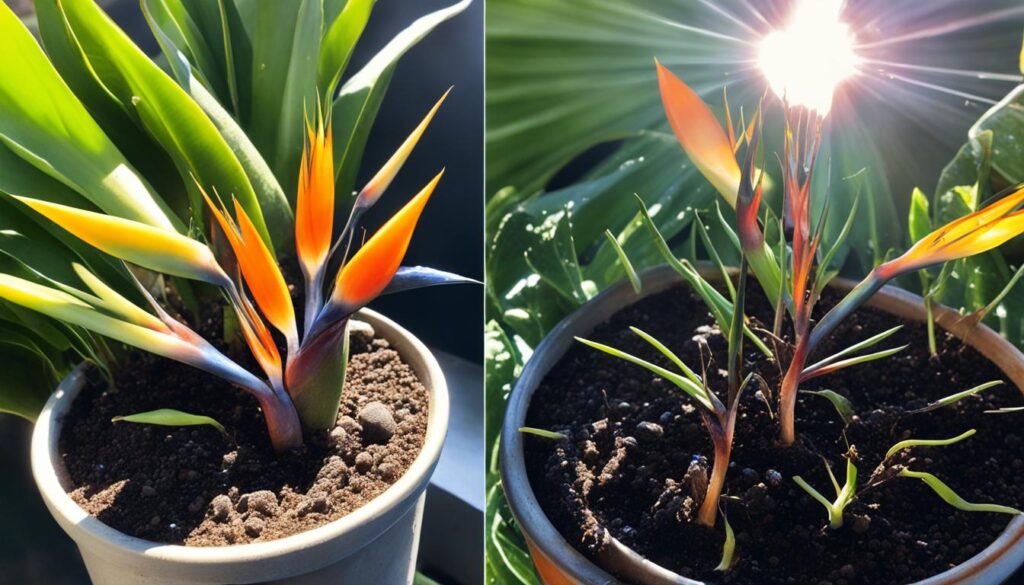
Best Time to Propagate Bird of Paradise
The best time to propagate your bird of paradise plant is in early spring. This is when the plant starts to grow new leaves, making it perfect for dividing. But, indoor plants can grow faster than expected, depending on the temperature and their health. So, you might need to divide your bird of paradise in late winter when it’s dormant.
Spring: The Ideal Season for Division
Dividing your bird of paradise in early spring is highly recommended. This is when the plant wakes up from its sleep, and new offsets grow at the base. By dividing it then, you help the new parts grow strong and healthy.
Offshoots, or suckers, help the bird of paradise spread. You can find these at the base of the plant. Cut them off with a sharp knife, making sure each piece has its roots. After dividing, the new plants may take a few weeks to settle. But, look for new growth to know they’re doing well.
“Dividing your bird of paradise in the early spring is the best way to ensure successful propagation. This is when the plant is just starting to wake up and the offsets are at their most active.”
Propagating Bird of Paradise: Division vs Seed
Gardeners have two main ways to grow bird of paradise plants: division and seed propagation. Each method has its pros and cons.
Division is a popular choice for gardeners. It’s a reliable way to grow new plants from the parent every 3-5 years. This fits well into your regular plant care routine, helping you expand your garden easily.
Seed propagation is more challenging but rewarding. It lets you start from scratch, but it takes months to a year for the seedlings to be ready. The success rate is lower than division, as seeds need the right conditions to grow.
Seed propagation can lead to genetic diversity. You might get plants with different colors, sizes, or blooms. But, it requires patience and may not always work out.
“Propagating bird of paradise through division is a practical and efficient method that allows for immediate expansion of your plant collection.”
Choosing between division and seed propagation depends on your gardening goals and time. Division is great for a quick, reliable way to grow more plants. Seed propagation is for those who enjoy the challenge and want genetic diversity.
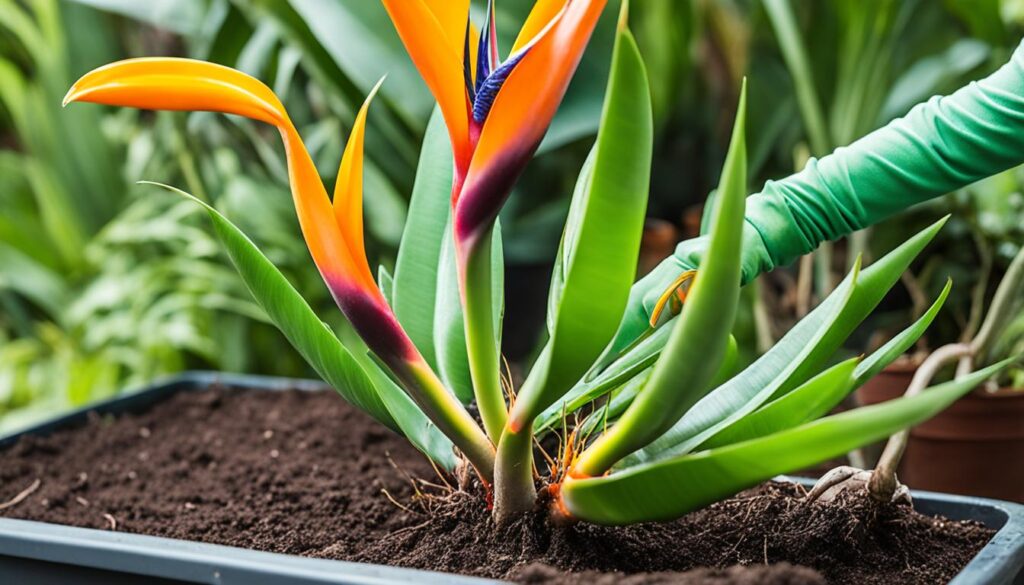
How to Propagate Birds of Paradise?
Propagating a Bird of Paradise plant through division is easy and rewarding. It lets you grow more of these beautiful tropical flowers. By following a step-by-step guide, you can divide your Bird of Paradise and create new, healthy plants.
Step-by-Step Guide to Division Propagation
To propagate a Bird of Paradise using division, just follow these easy steps:
- Carefully remove the entire plant from its pot, making sure the soil around the roots is loose.
- Use a sharp, clean knife to cut off a section of the plant’s rhizome (horizontal stem). Make sure each division has at least one living fan with roots.
- Apply a rooting hormone evenly across the open incisions on the divided stems to help root growth.
- Prepare new pots with a well-draining potting mix and plant the divided sections. Make sure they are at the same depth as the original plant.
- Water the newly divided plants gently and place them in a warm, bright spot to help them settle.
By following this step-by-step bird of paradise division process, you can successfully propagate bird of paradise. Enjoy the beauty of these tropical plants in your garden or home.
“Propagating Bird of Paradise plants through division is a rewarding and efficient way to expand your collection.”
Propagating Bird of Paradise from Seeds
If you want to grow your own bird of paradise plants, starting with seeds is a great choice. This plant is famous for its beautiful flowers and leaves. Let’s look at how to grow bird of paradise from seed and the steps of bird of paradise seed propagation.
Seed Harvesting and Preparation
To start, you need to collect the seeds. You can get them from your own plant or buy them. After getting the seeds, soak them in water for 24 to 48 hours. This makes their hard shells softer.
Then, grind the seeds to remove any orange tufts of hair. This gets them ready for planting.
Sowing and Germination Process
With your bird of paradise seeds ready, it’s time to plant them. Put the seeds about half an inch to 1 inch deep in a moist pot or tray. Keep the soil wet and wait – it can take 8 weeks or more for them to sprout.
Once they start growing, they’ll take about 4 to 7 years to bloom. To help them grow, make sure they have warm, humid conditions and lots of sunlight. Also, use a slow-release fertilizer to feed them.
“Propagating bird of paradise from seeds requires patience and the right conditions, but the results can be truly rewarding.”
Starting with seeds takes longer than other ways, but it’s exciting. You get to see the plant grow from the beginning. With care, your bird of paradise seedlings will become beautiful plants. They’ll add a tropical feel to your garden or indoor area.

Considerations for Bird of Paradise Propagation
Starting to grow a bird of paradise plant requires careful thought. These plants need a bit more care than others. But, with the right knowledge, you can grow these beautiful plants easily.
Understanding Root Requirements
When you want to grow a bird of paradise, think about its roots first. You can’t just take a leaf or stem cutting and expect it to grow into a new plant. Bird of paradise propagation needs a part of the plant’s root system to work. This part is called the rhizome and has the root hairs needed for new roots and stems.
The bird of paradise can grow really tall, up to 2 meters. Its strong roots support this height. So, make sure your new plant has enough roots to grow big and healthy. If you ignore the roots, your plant might not grow well or at all.
“The bird of paradise plant requires a little more than leaf and stem cuttings to reproduce successfully. The plant’s root has a lot of material for the new plant to grow.”
Knowing what your bird of paradise needs is key to success. Paying attention to its root needs helps you grow strong, beautiful plants. These plants can brighten up your home or garden with their lovely flowers.
Can You Propagate Bird of Paradise in Water?
Many think you can grow a Bird of Paradise plant in water, but it’s not true. This plant needs a solid root system to support its growth. Without roots, it can’t grow well in water.
The Bird of Paradise comes from South Africa and is loved for its beauty. It’s grown around the world as a decoration. But, you can’t propagate it in water. You must use division or seed sowing instead.
“Roots must develop in cut sections to support new growth. This allows new stems and roots to emerge as the roots spread and firm up the plant. There is no root system for a Strelitzia leaf to grow on in the water, so it cannot grow. Therefore, it will not be possible for the plant to reproduce successfully.”
To grow a Bird of Paradise, division or seed propagation works best. Division is simple and uses the parent plant’s rhizome to make new ones. Seed propagation takes longer but can give you different types of plants.
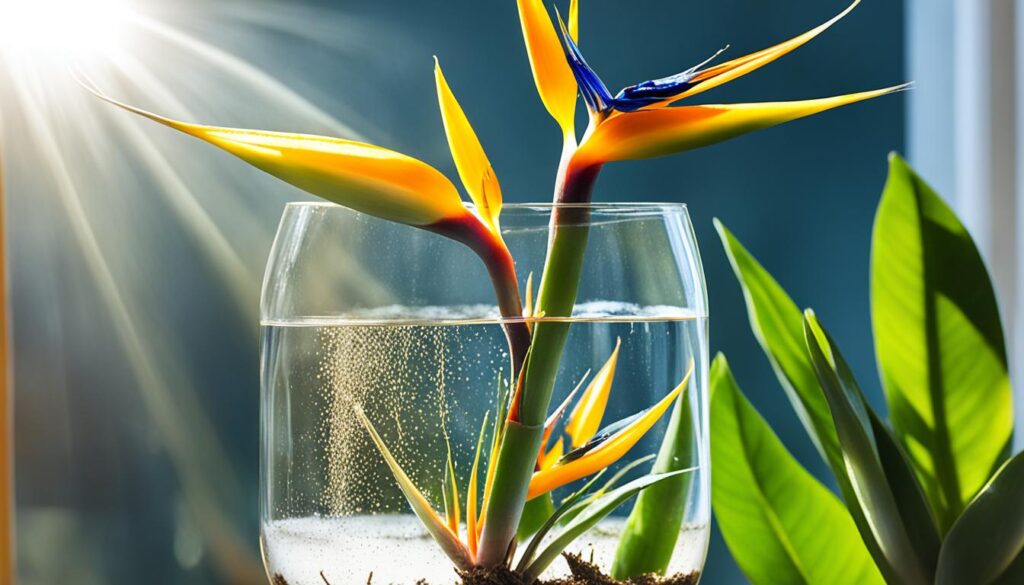
Choosing how to propagate is important for the Bird of Paradise’s success. You need to pay attention to sunlight, water, and soil to help it grow and bloom well.
Planting Bird of Paradise Without Roots
Planting bird of paradise plants needs roots. Cuttings without roots won’t grow. The rhizome, with its root hairs, is key for new roots and growth.
Bird of paradise seeds can take a year to start growing. Young plants may wait seven years to bloom. They need a steady temperature of 50-72°F (10-20°C) to grow well. Good watering, drainage, and fertilizing are also important.
“Planting bird of paradise without roots is simply not possible. The rhizome and root system are essential for the plant to establish itself and grow successfully.”
Trying to grow bird of paradise without roots won’t work. The plant needs roots to get water and nutrients and to stay in the ground. Without roots, the cutting will just die.
To grow bird of paradise plants, use division or seeds. Both methods need a healthy root system. Knowing what the plant needs helps gardeners succeed with their bird of paradise plants.
Caring for Newly Propagated Bird of Paradise
Taking care of your new bird of paradise needs a gentle touch. These plants have special needs for light, temperature, humidity, water, and soil. Meeting these needs helps your plants grow strong and healthy.
Light, Temperature, and Humidity Requirements
Your young bird of paradise needs lots of light. Make sure it gets full sun for at least six hours a day. It likes warm temperatures and doesn’t do well in the cold.
Keeping the right humidity is also important. If your home is dry, you might need a humidifier or a pebble tray to add moisture around your plant.
Watering and Soil Preferences
Don’t overwater your bird of paradise. Water it only when the topsoil feels dry. For the best soil, mix rich loamy soil with sand or perlite for good drainage. This mix helps your plant grow well.
By focusing on care for propagated bird of paradise, lighting, temperature, humidity requirements for bird of paradise, watering, and soil preferences, you’ll help your plant thrive. You’ll get to enjoy its beautiful flowers for many years.

Troubleshooting Common Propagation Issues
Propagating the stunning bird of paradise can be rewarding but has challenges. Don’t worry, we’re here to help. We’ll cover common issues like overwatering and the need for patience.
Overwatering is a common mistake that can harm your bird of paradise. If your plant looks wilted and has yellow leaves, it’s getting too much water. Make sure to let the soil dry out a bit between waterings to avoid root rot.
Root rot is another issue to watch out for. It happens when the soil doesn’t drain well. Use a mix with perlite or orchid bark to help with drainage. This keeps the roots healthy and strong.
- Overwatering can lead to yellow, drooping leaves and soggy soil
- Root rot can be caused by poor drainage and overly moist conditions
- Amend your soil mix with perlite or orchid bark to improve drainage
Patience is key when propagating bird of paradise. Don’t expect quick results; it’s a long process. Trust the process and give your plant time to grow.
“Propagation is more marathon than sprint.”
With some troubleshooting and care, you can overcome bird of paradise propagation challenges. Each plant is different, so adjust your methods as needed. Keep an eye on your plants and get expert advice if you’re unsure. Your hard work will pay off with beautiful tropical plants.
Tips for Successful Bird of Paradise Propagation
Propagating a bird of paradise can be rewarding with the right care. Here are some tips for propagating bird of paradise and secrets to successful bird of paradise propagation. These tips will help you succeed:
- Lighting is Key: Bird of paradise plants love sunlight. They need at least six hours of bright, indirect light daily. Don’t put your plant in direct sunlight during the hottest part of the day, as it can harm the leaves.
- Fertilize Wisely: Fertilizer is crucial for a healthy bird of paradise. Use it when the plant is growing, usually in spring and summer. Always follow the instructions on the fertilizer package to prevent over-fertilizing.
- Time it Right: Late winter is the best time for dividing your plant. It’s when they rest and are ready for a change. For sowing seeds, fall is the best season. It’s like sending your kids to school; they grow up, but it takes time.
By using these tips for propagating bird of paradise and secrets to successful bird of paradise propagation, you’ll grow a thriving plant. Remember, patience and careful attention are essential for success.
“The bird of paradise is a stunning and unique plant that can bring a touch of the tropics to any home or garden. With the right care and propagation techniques, you can enjoy its beauty for years to come.”
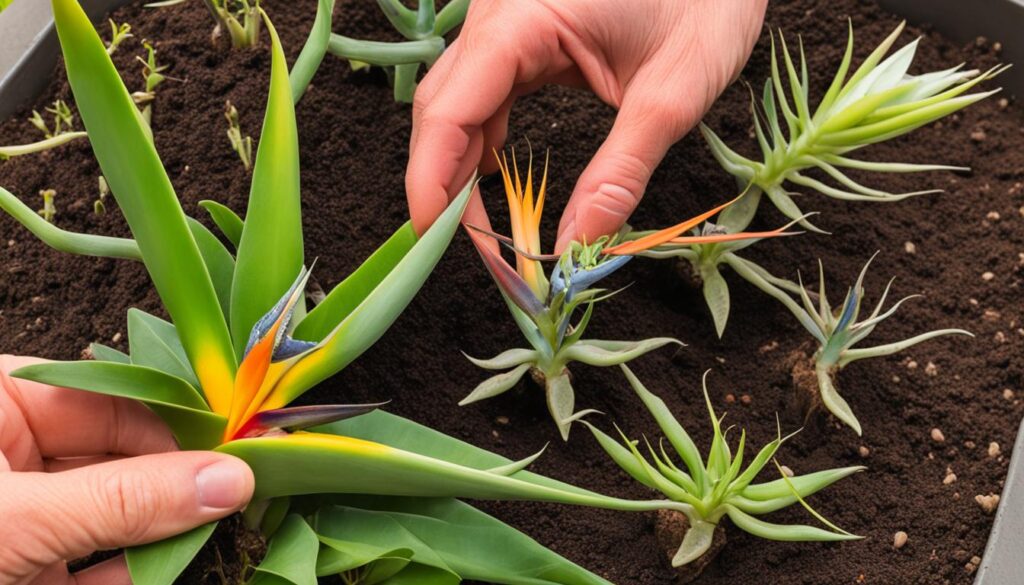
Conclusion
Propagating bird of paradise plants is rewarding for gardeners. You can either divide your plant or grow from seed. It’s important to know the specific needs and follow the right steps. With care and attention, you can multiply these beautiful tropical plants and enjoy them for years.
This guide has given you the knowledge and steps to grow your own bird of paradise. You learned the best ways to propagate and the seasons for it. You also learned about seed germination and the plant’s needs for light, temperature, soil, water, and maintenance.
Starting your bird of paradise propagation journey requires patience and care. With the right approach, you can make your garden more tropical and create a lush oasis. By using the insights and techniques from this article, you’ll find propagating bird of paradise plants a successful and rewarding experience.
FAQ
What are the benefits of propagating a bird of paradise plant?
Propagating a bird of paradise plant keeps your plant alive for years. It helps you learn about its growth and care. Plus, it lets you divide the plant if it gets too big or roots appear from the container.
When is the best time to propagate a bird of paradise?
The best time to divide your bird of paradise is early spring when new growth starts. For indoor plants, you might need to divide in late winter when it’s dormant.
What are the two main methods of propagating a bird of paradise?
You can propagate a bird of paradise through division or seed. Division is quick and can be done during repotting. Seed propagation takes longer but is another way to grow new plants.
How do you propagate a bird of paradise through division?
Start by taking the plant out of its pot and gently loosening the soil around the roots. Then, use a sharp knife to cut a section of the rhizome, making sure each piece has roots and a living fan.
Apply rooting hormone to the cuts and plant the divisions in pots filled with good potting mix.
Can you propagate a bird of paradise from just a leaf or stem cutting?
No, you can’t propagate a bird of paradise from just a leaf or stem cutting. The plant needs a piece of the rhizome with root hairs for new roots and stems. Cuttings without roots won’t grow into new plants.
Can you propagate a bird of paradise in water?
No, propagating a bird of paradise in water is not possible. The plant needs a root system for growth, and water won’t help roots develop. Cuttings without roots can’t be planted and won’t grow into new plants.
What are the key requirements for caring for a newly propagated bird of paradise?
New bird of paradise plants need lots of sunlight (at least 6 hours a day), warm temperatures, high humidity, and soil that drains well and has nutrients. Be careful not to overwater, as this can cause root rot. Remember, these plants grow slowly, so be patient.
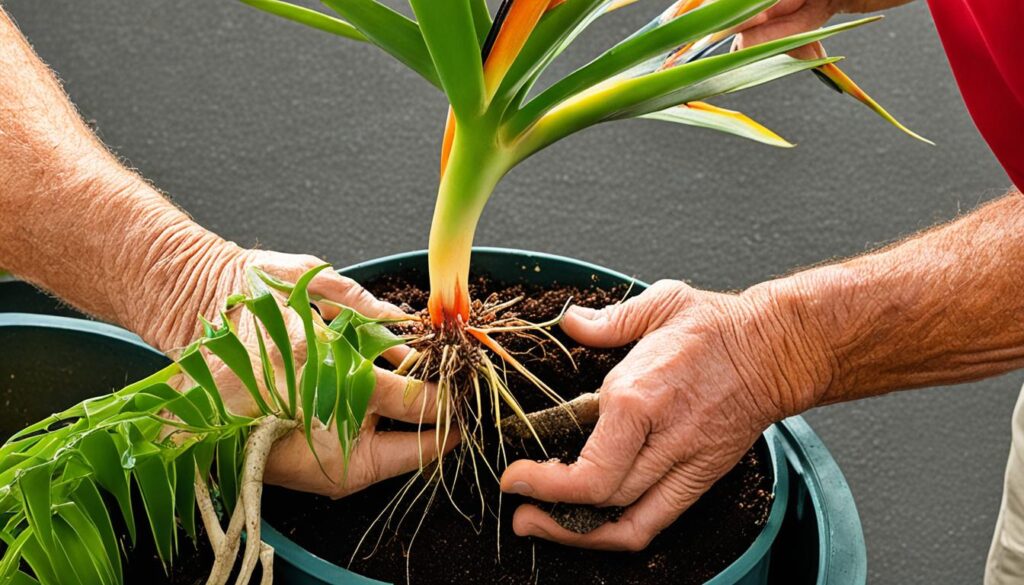

аккаунт для рекламы магазин аккаунтов
услуги по продаже аккаунтов продажа аккаунтов
профиль с подписчиками профиль с подписчиками
маркетплейс для реселлеров купить аккаунт
маркетплейс аккаунтов соцсетей купить аккаунт
профиль с подписчиками продать аккаунт
гарантия при продаже аккаунтов площадка для продажи аккаунтов
маркетплейс аккаунтов https://birzha-accauntov.ru
купить аккаунт с прокачкой https://birzha-akkauntov-online.ru/
платформа для покупки аккаунтов https://marketplace-akkauntov-top.ru/
платформа для покупки аккаунтов перепродажа аккаунтов
купить аккаунт prodat-akkaunt-online.ru/
биржа аккаунтов https://kupit-akkaunt-top.ru/
купить аккаунт с прокачкой платформа для покупки аккаунтов
Website for Buying Accounts Gaming account marketplace
Account marketplace Account exchange
Website for Buying Accounts Purchase Ready-Made Accounts
Sell Account Account Buying Platform
Account Exchange Service Accounts for Sale
Account marketplace Purchase Ready-Made Accounts
Account market Account marketplace
Account Exchange Service https://socialmediaaccountsshop.com/
Account Catalog https://accountsmarketplaceonline.com/
Purchase Ready-Made Accounts Buy accounts
Sell Account Sell Pre-made Account
account trading platform account acquisition
account acquisition website for selling accounts
account exchange service account exchange service
account selling service database of accounts for sale
account buying service account trading service
account exchange https://buycheapaccounts.com
gaming account marketplace account trading service
verified accounts for sale account selling platform
account purchase buy pre-made account
sell account sell accounts
account sale account trading
buy and sell accounts account exchange service
ready-made accounts for sale buy pre-made account
gaming account marketplace online account store
find accounts for sale find accounts for sale
website for buying accounts website for selling accounts
sell pre-made account accounts for sale
account catalog account selling platform
database of accounts for sale accounts market
account marketplace account market
account sale secure account purchasing platform
database of accounts for sale account market
account sale accounts marketplace
sell account purchase ready-made accounts
account store account market
account trading secure account purchasing platform
secure account purchasing platform account market
purchase ready-made accounts social media account marketplace
account selling platform https://accounts-offer.org
buy pre-made account https://accounts-marketplace.xyz
database of accounts for sale https://buy-best-accounts.org/
accounts for sale https://social-accounts-marketplaces.live/
account sale accounts marketplace
sell accounts account marketplace
gaming account marketplace https://buy-accounts.space/
account trading https://buy-accounts-shop.pro
secure account purchasing platform account market
buy account https://social-accounts-marketplace.live
account selling service https://buy-accounts.live
social media account marketplace accounts-marketplace.online
маркетплейс аккаунтов соцсетей https://akkaunty-na-prodazhu.pro
биржа аккаунтов https://rynok-akkauntov.top
магазин аккаунтов kupit-akkaunt.xyz
купить аккаунт https://akkaunt-magazin.online
биржа аккаунтов https://akkaunty-market.live
покупка аккаунтов https://kupit-akkaunty-market.xyz
маркетплейс аккаунтов akkaunty-optom.live
биржа аккаунтов https://online-akkaunty-magazin.xyz/
покупка аккаунтов akkaunty-dlya-prodazhi.pro
покупка аккаунтов https://kupit-akkaunt.online/
facebook account sale facebook ads accounts
facebook ads account buy buy facebook account
cheap facebook accounts buy facebook account
buy a facebook ad account buy aged facebook ads accounts
buy a facebook ad account https://ad-account-buy.top/
buy a facebook account https://buy-ads-account.work
cheap facebook advertising account buy a facebook account
buying facebook accounts facebook account buy
buy facebook advertising accounts buy facebook ads account
buy google ads account adwords account for sale
buy google ad threshold account buy adwords account
buy facebook ads manager buy facebook accounts for ads
buy google ad account https://ads-account-for-sale.top
sell google ads account https://ads-account-buy.work
buy google ads accounts https://buy-ads-invoice-account.top
google ads account seller https://buy-account-ads.work
buy aged google ads account https://buy-ads-agency-account.top
google ads agency account buy https://sell-ads-account.click